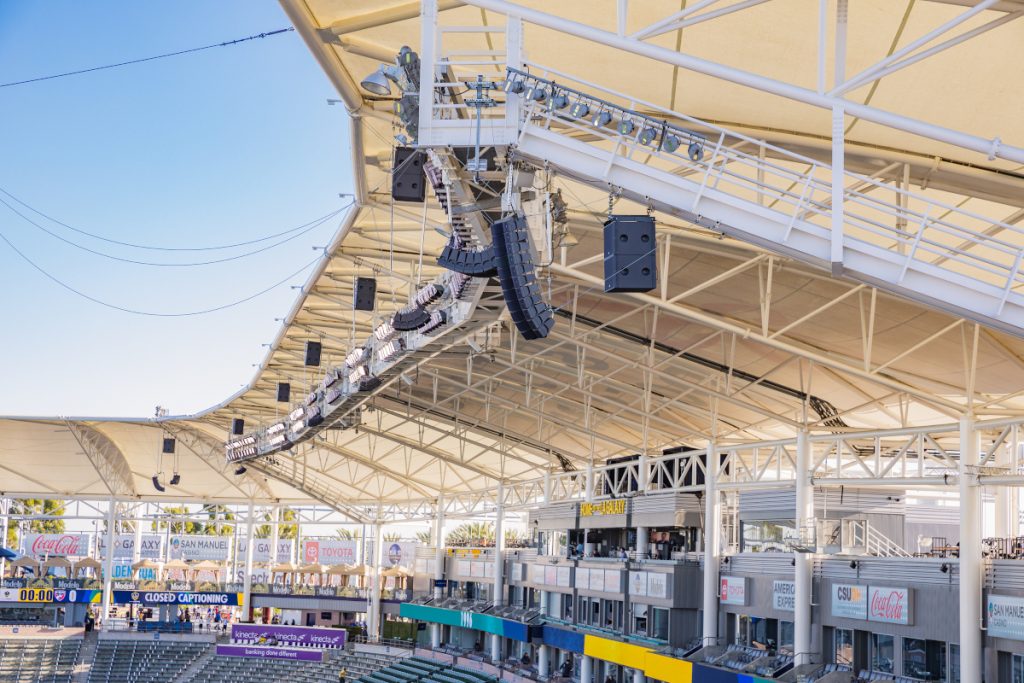Installing an audio system in an outdoor athletic facility that’s located near a residential area is a tricky prospect; you have to ensure that the sound system is equal to the ever-rising standards of high-energy sporting events while still keeping noise complaints from the neighbors to a minimum (not to mention handling the usual headaches associated with designing sound for outdoor environments).
That was the task that 3G Productions faced during a recent sound-system upgrade at Dignity Health Sports Park, a multiuse sports complex that primarily serves as the home of Major League Soccer (MLS)’s LA Galaxy, as well as the temporary home for the National Football League (NFL)’s Los Angeles Chargers. The sprawling complex encompasses a number of different venues, and the scope of this project included upgrades to some of the park’s marquee spaces: the 27,000-seat main soccer stadium (which is also used for Chargers games), the soccer stadium’s concourse areas and the complex’s 8,000-seat tennis stadium. In addition, the integrator designed and installed a completely new head-end system to control audio throughout the venue.
Project Goals
Dignity Health Sports Park is located on the campus of California State University, Dominguez Hills, which presented a number of unique challenges in designing the audio system. “The venue is adjacent to California State Dominguez Hills to the east and residential communities to south, west and north,” Adam Duvendeck, VP of Operations at Dignity Health Sports Park, described. “So, one of the particular issues that we looked to solve was the bleeding of sound and focusing that sound within the stadium—trying to provide positive energy and impact for our guests, but not disturbing the university and surrounding residential neighbors.”
In addition to fixing the bleed issues, the upgrade was also meant to address a number of practical concerns. For one, the complex was still using the same audio system that had been installed during its initial construction 15 years prior to the beginning of this project. That audio system was subject to degradation due to wear and tear and exposure to the elements. The other goals of the project were to add low-end support within the main bowl and to expand audio coverage to the concourse and other areas that previously lacked sound reinforcement.
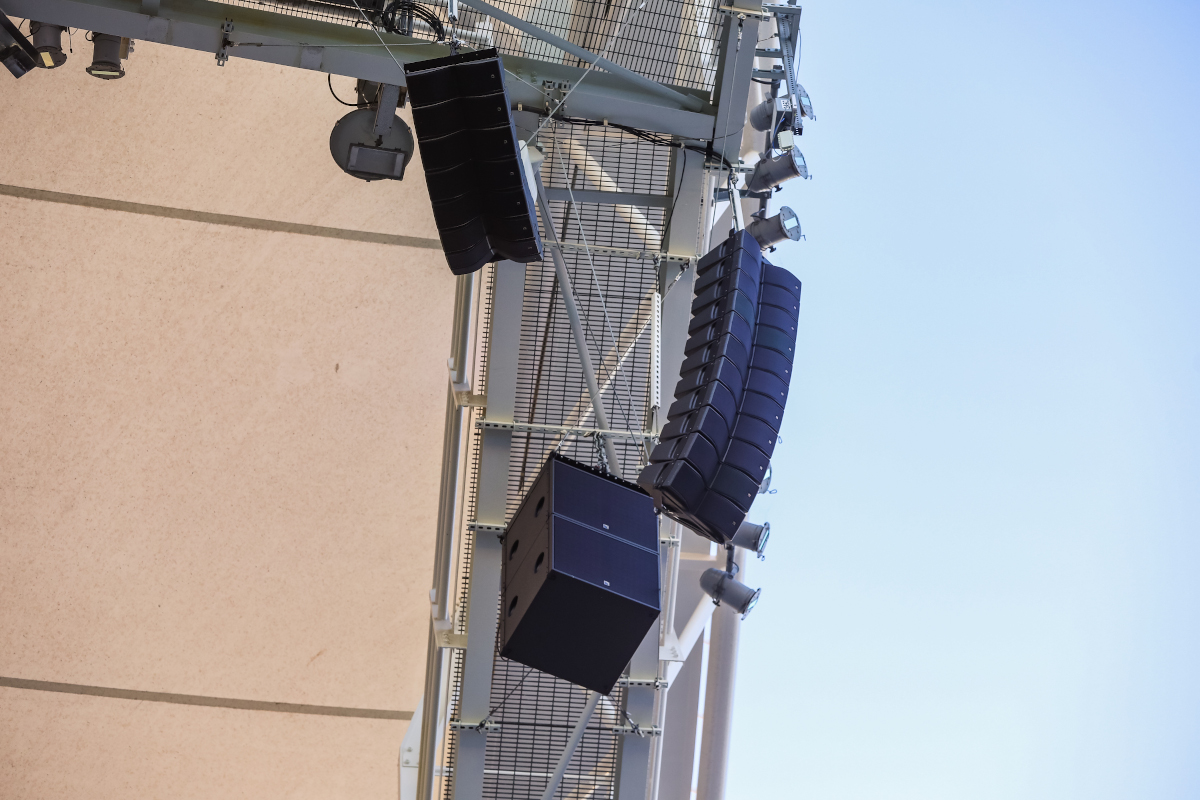
Of course, the age of the initial system meant that it was 15 years behind current technology, and, during those intervening years, AV expectations for athletic venues—particularly those that host professional teams—have evolved quite a bit. With those evolving expectations for the fan experience in mind, Dignity Sports Health Park wanted to prioritize delivering a live experience that would live up to the energy of the fans in the stands (especially the more raucous members of the LA Galaxy’s fanbase, who, from their seats in the stadium’s three designated supporter sections, set the tone for the rest of the crowd).
“The north end of the stadium is where two of our supporter groups are,” Duvendeck shared. “Supporter culture is a big part of soccer. I think we had a lack of audio in that area in the initial system, and that was definitely an area that we wanted to address during the retrofit.”
In addition to meeting higher fan expectations, the new audio system would also have to live up to the expectations of professional players, staff and coaches. According to Duvendeck, this meant keeping as much noise as possible off the field—for soccer games especially—so that the players and coaches would not be distracted by the audio used to create the fan experience in the stands.
“With soccer, we want to direct the audio to the fans and not to the field,” Duvendeck explained. “The previous system was more of an audio flood: We had a number of speaker banks up in the catwalk with zoning capabilities, but focusing the audio in certain locations was more difficult.”
Another factor that necessitated the audio upgrade was the never-ending AV arms race in public venues of every type. In an entertainment-rich market like California, which boasts a larger number of professional sports teams than just about anywhere in the US, Dignity Health Sports Park faces some stiff competition in its attempts to woo fans into the stands. In that sense, the audio upgrade has made the venue more competitive not only in the professionalsoccer market, but also in the highly competitive professional-football market.
“The overall design intent was really with the Galaxy in mind, but, obviously, all of these positive improvements have had a major effect for the Chargers,” Duvendeck said. “Creating that high-energy fan experience is the NFL’s bread and butter. I think that, if you ask the Chargers, the previous system probably wasn’t delivering the full experience that they wanted. But the improvements that have been provided by the new system totally blew them away and are now a focus of how they design their in-house show.” He added, “With new stadiums being built in-market—the Los Angeles Football Club (LAFC) just two years ago and the new stadium in Inglewood CA coming online next year—making sure that we’re delivering state-of-the-art technology and ensuring that we’re leaders in the fan experience world are critically important to not only the stadium, but also the club.”
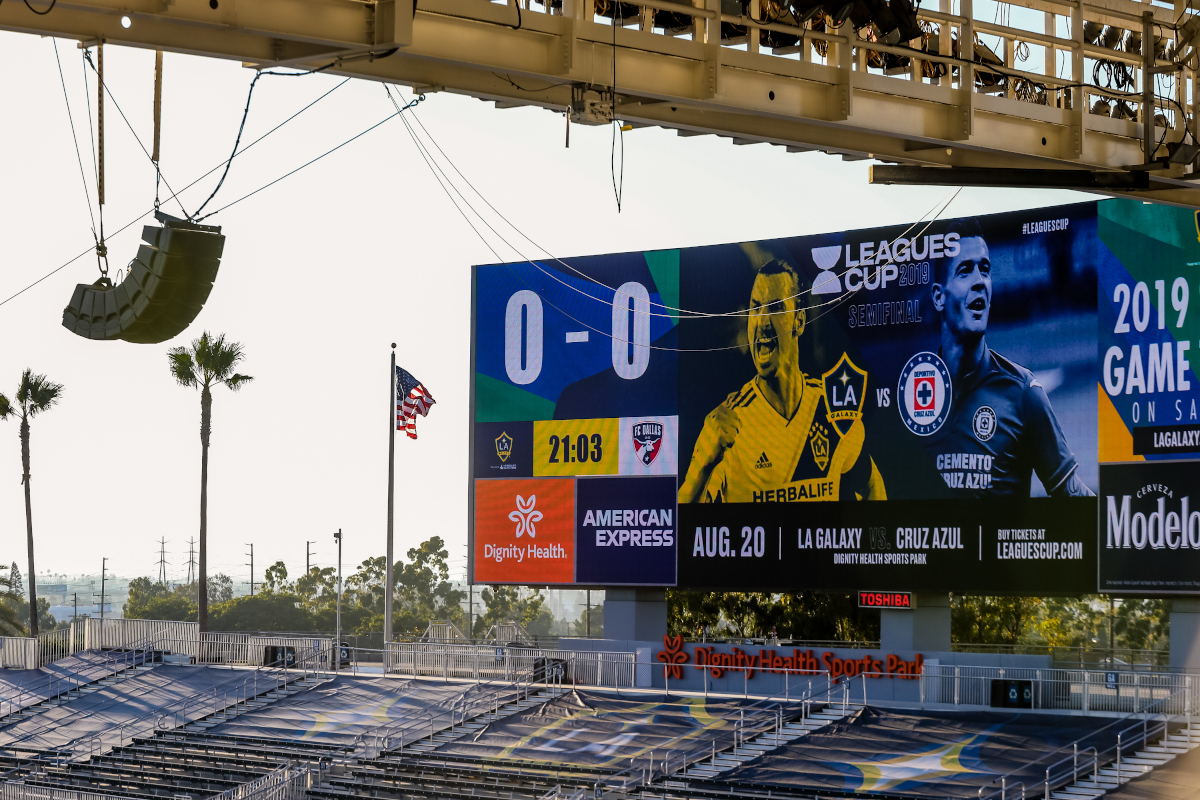
Main Bowl Audio
Anschutz Entertainment Group (AEG), owner and operator of Dignity Health Sports Park, put the project out for bid, and 3G Productions’ multi-zone design for the stadium’s bowl, which relied heavily on line-array speakers, proved to be the winner. Key personnel on the team from 3G Productions included System Designer and Engineer David Myers, Project Manager Don Hartley and Foreman Jame Giddens. 3G’s Chief Operating Officer, Keith Conrad, provided information about the project.
When asked why AEG decided to go with 3G, Duvendeck responded, “They were the only company that presented a line-array system. The line-array solution for our venue and the modeling that 3G did in advance of their proposal—really looking at and identifying the challenges that we have and how to solve them—were very big reasons why we decided to go with them. We also have a familiarity with 3G because of the work that our touring and concert division does with them.” He continued, “I think they were uniquely qualified to understand some of the sound-bleed issues that we were having in our facility. So, there was a familiarity that 3G had with our venue, and they really understood the issues and concerns that we had. I think they uniquely addressed all those issues.”
For the biggest piece of the installation—the soccer stadium’s main bowl—3G designed a system built on L-Acoustics’ KIVA II line-array platform, supported by the LAcoustics SB18i subwoofer. A total of 142 KIVA-II line arrays and 28 SB18i subwoofers are installed throughout the stadium; these are powered by a total of 18 L-Acoustics amplifiers (five LA4Xes and 13 LA12Xes), which are stored in equipment racks located up in the catwalks.
“By using [the KIVA-II line arrays] throughout the whole venue, we designed a system that is scalable to accommodate each of the unique listener areas,” Conrad explained. “It also maintains the same tonal voicing and acoustical characteristics throughout the venue and maximizes the horizontal dispersion control.” He continued, “The amplifiers are all four-channel amplifiers, and each of the loudspeaker arrays in each zone is independently addressable for gain and muting using the head-end system.”
The main-bowl sound system features eight autonomous zones of coverage, the zones being roughly defined by the areas of seating that they cover. The volume level of each zone can be controlled independently, and each zone can be turned off entirely when that area of seating is not occupied. The modular control over the independent audio zones, as well as the carefully selected coverage angles of the line-array speakers, is the means by which the new system prevents noise pollution to the park’s surrounding residential areas.
“We have a pretty granular ability to modulate the sound throughout the stadium,” Duvendeck said. “Outside of the Galaxy and the Chargers, we also have a number of events here throughout the year that may not draw the types of fanbases that we see during the MLS and NFL games. For example, we might host a collegiate soccer match where we only seat the lower bowl or only seat the east side of the stadium. The new system gives us the ability to focus the audio on those specific areas, which helps with a lot of the sound-bleed issues.”
In addition to wanting to reduce audio bleed into the surrounding neighborhood, AEG wanted to prioritize keeping as much amplified audio as possible off the playing field, thereby facilitating communication between the players and coaches, while also accommodating TV broadcasts of the professional-level games that are played in the stadium. With that in mind, the placement and coverage angles of the line arrays were modeled using L-Acoustics Soundvision to cover the seating areas evenly, while also reducing the bleeding effect and keeping the noise level on the playing field to a minimum.
“We used these mini line arrays—and a multitude of them, as opposed to doing an end stage or something like that—to keep the noise away from the field,” Conrad described. “We had to do a lot of different hangs and divide the system into more zones to really accommodate keeping the noise off the field, as well as to keep the noise away from the neighborhood. [The system is] unique in that, when you go to a lot of stadiums, they’re end-zone-based: They have a big scoreboard with huge line arrays, and that’s how they cover the majority of the stadium. This system has none of that. [The arrays] are hung just off the canopy around the stadium, and it’s all small clusters shooting outward. So, it’s very unique and specialized.” He added, “We also wanted to provide uniform audio coverage throughout the various areas. So, we were very particular in how we designed this [to ensure] that there is universal coverage throughout the stadium.”
According to Duvendeck, 3G’s solution had the desired effect of delivering high-energy audio to the stands while keeping things relatively quiet on the field. “With the line-array solutions that 3G [installed] and the modeling that they were able to show us—which we really have found to be true and accurate—you have this high intensity and energy throughout the stands,” he described. “But, literally, within a 10- to 20-foot jump onto the field, that decibel level comes way down.”
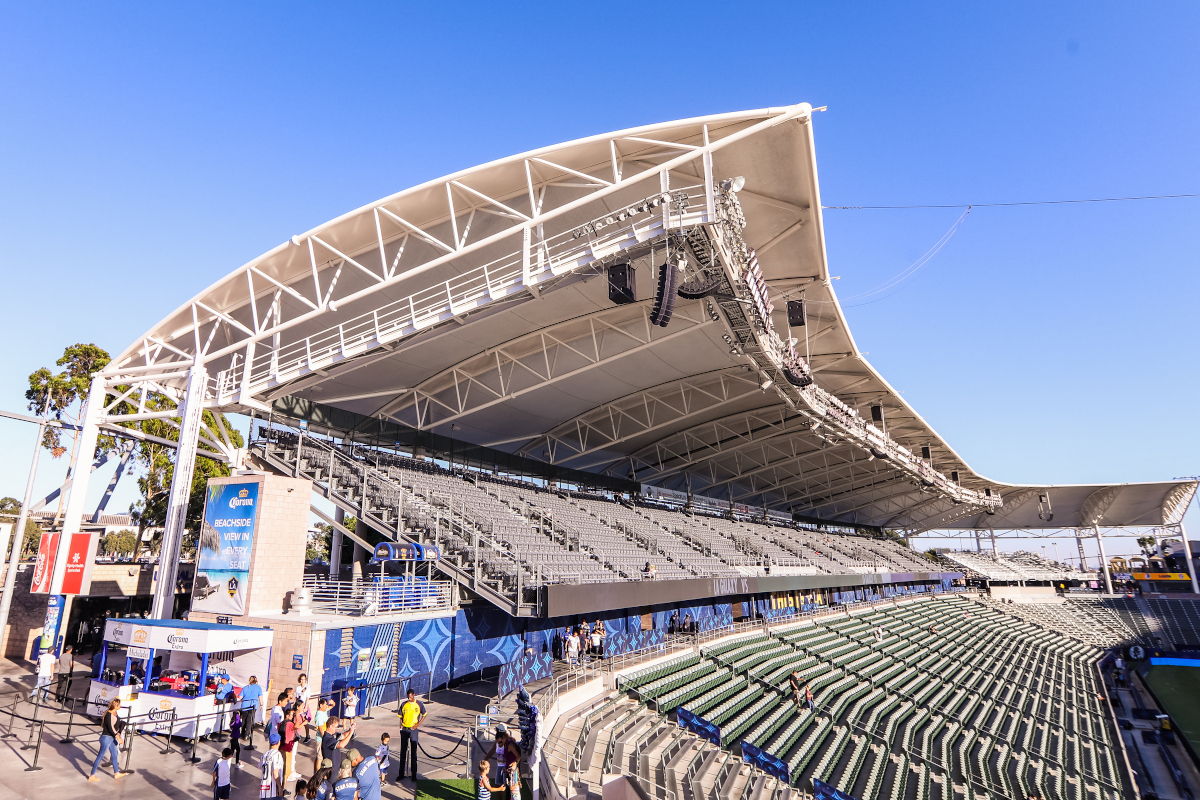
Concourse Audio
In addition to remodeling the main-bowl audio system, one of the major parts of this project included expanding audio coverage to the main concourse, which previously had not been equipped with sound reinforcement. The concourse area includes concessions, restrooms and the park’s main entrance gates. The lack of audio coverage in such high-traffic areas was detrimental to the fan experience at Dignity Health Sports Park; as such, correcting this was a top priority.
“They saw that, during games, people didn’t want to leave their seats, [meaning] concession sales would be low,” Conrad said. “So, they really wanted to have a supporting sound system throughout the concourse and in the bathrooms so that people felt like they were still connected to what was going on in the game while they went to either relieve themselves or grab a drink or food.”
The concourse is covered by 75 Community R Series outdoor loudspeakers. “We designed a system that’s scalable to accommodate all these different listening areas while maintaining the same tonal voice and acoustical characteristics, which is very important,” Conrad explained. “The concourse system was divided into a total of eight zones. And each of those zones has different architecture and characteristics that required various horizontal coverages, output levels or throw distances. So, we used the R Series throughout, but we used different speakers throughout.”
Conrad provided some examples of how the 3G team chose a specific R Series speaker for each area. “For the west concourse area, we used the R5.66 loudspeakers because their coverage angle was 60°x60°, [which is intended] for a design with high output and long throw in an outdoor application. There are 15 of these speakers throughout, and these were mounted on existing steel poles outlined on the edge of the concourse, along the concession booths.” However, it’s completely different for the east concourse area. “On the east side,” Conrad continued, “we used Community R.35 coaxial speakers, and these have 90°x90° coverage. [These are] kind of high output, but more of a medium throw, [and we used them] because it’s a little bit smaller of an area, width-wise. It’s an outdoor application, and the speakers were mounted along the west-facing wall of the concession booths.” Whereas R Series speakers were used throughout the outdoor areas of the concourse, the restrooms were all outfitted with Community AD-C6T ceiling speakers. A total of 10 QSC CXD 4.5Q amplifiers are used to power the various speakers throughout the concourse.
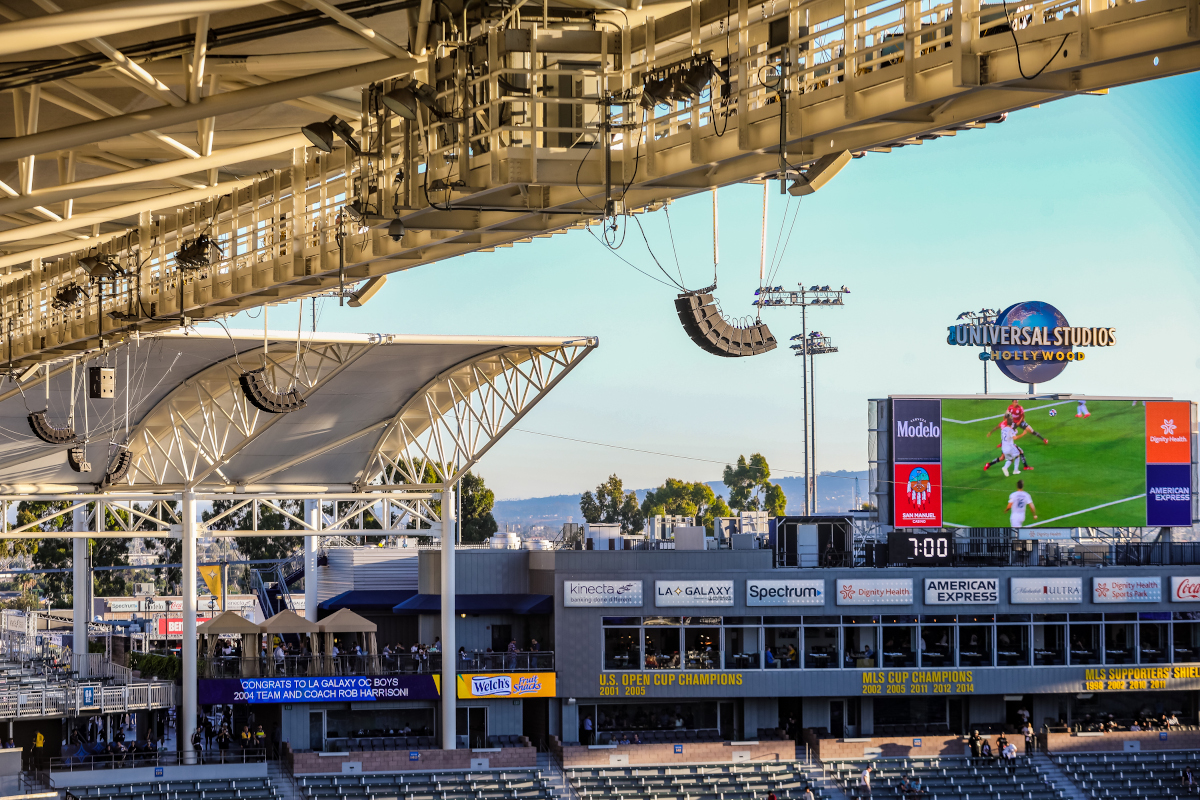
Tennis/Boxing Stadium Audio
The final area of Dignity Health Sports Park that this installation affected was the venue’s tennis stadium (which, as of this writing, is used primarily to host boxing matches). The main goal for this part of the project was to improve the sound system’s speech intelligibility.
“This was a really small part of the overall installation,” Conrad shared. “We just upgraded the loudspeakers and the amplifiers. The existing system was composed of eight two-way, surface-mounted loudspeakers that were kind of mounted on the ends of each of the four tennis courts. We just replaced those with a total of eight Community horn-loaded loudspeakers, and [we] did some aiming and commissioning for optimal coverage and performance. [Previously,] the performance and reliability of the announcements and the background music was really bad, and it was just old technology. So, they wanted an improvement in speech intelligibility. That was the most important part of that.”
In addition to the eight Community R.5-99TZ loudspeakers that cover the tennis courts, 3G also installed six QSC AD-S8TBKs as concourse-facing loudspeakers. All the speakers in the tennis stadium are powered by four QSC amplifiers (two CXD4.5s and two CXD4.3s).
Head-End System
Tying all the aforementioned audio endpoints together is Dignity Health Sports Park’s new head-end system. “The head-end system is composed of an integrated QSC Q-LAN, Dante, AVB, AES and analog distributed digital-audio network that is supported by a multi-mode fiberoptic infrastructure,” Conrad described. “It’s responsible for digital audio transmission throughout the venue, digital signal processing, system tunings, and controls such a power on/off, muting, gain adjustments and presets. So, it’s kind of responsible for everything.” Dignity Health Sports Park’s in-house production team runs the head-end system, but 3G has the ability to access the system remotely via TeamViewer to assist with troubleshooting.
The head-end system is designed with redundancy in mind. It features two Q-SYS Core 510i integrated processors and redundant network switches; in case one of the Core processors fails, the backup processor is activated immediately. “Each of these mission-critical devices is supported by an uninterrupted power supply (UPS) with a 10-minute runtime in the event of power loss,” Conrad added.
The components that make up the digital audio network are housed in the venue’s broadcast control booth. “We modified the existing amplifier equipment rack to house the core components of the digital audio network,” Conrad began, “which include the two Core processors; two I/O frames; a seven-inch touchscreen controller; a rackmount computer; a rackmounted keyboard, mouse and monitor; three network switches; and a UPS.” He continued, “The existing distributed-zone audio amplifiers were connected to the analog I/O devices in this equipment rack to be controlled and processed via the same digital audio network as the rest of the system. The I/O frames provide a total of eight analog inputs, eight analog outputs and eight AES inputs/outputs as patchable sources and system inputs.”
Conrad continued, saying, “The Core processors are equipped with redundant AVB and Dante digital audio cards. These processors serve as a digital audio bridge between these formats and ensure delivery of digital audio signals to the L-Acoustics amplifiers in their native AVB format, because AVB and Dante don’t always work that well together.” He added, “That’s something that we always have to work through with L-Acoustics—getting AVB to properly talk through Dante.” A redundant multi-mode 50/125 fiber loop was installed between the control booth and the four amplifier equipment racks located in the catwalks above the main bowl to deliver AVB digital audio signals from the Core processors to each of the amplifiers.
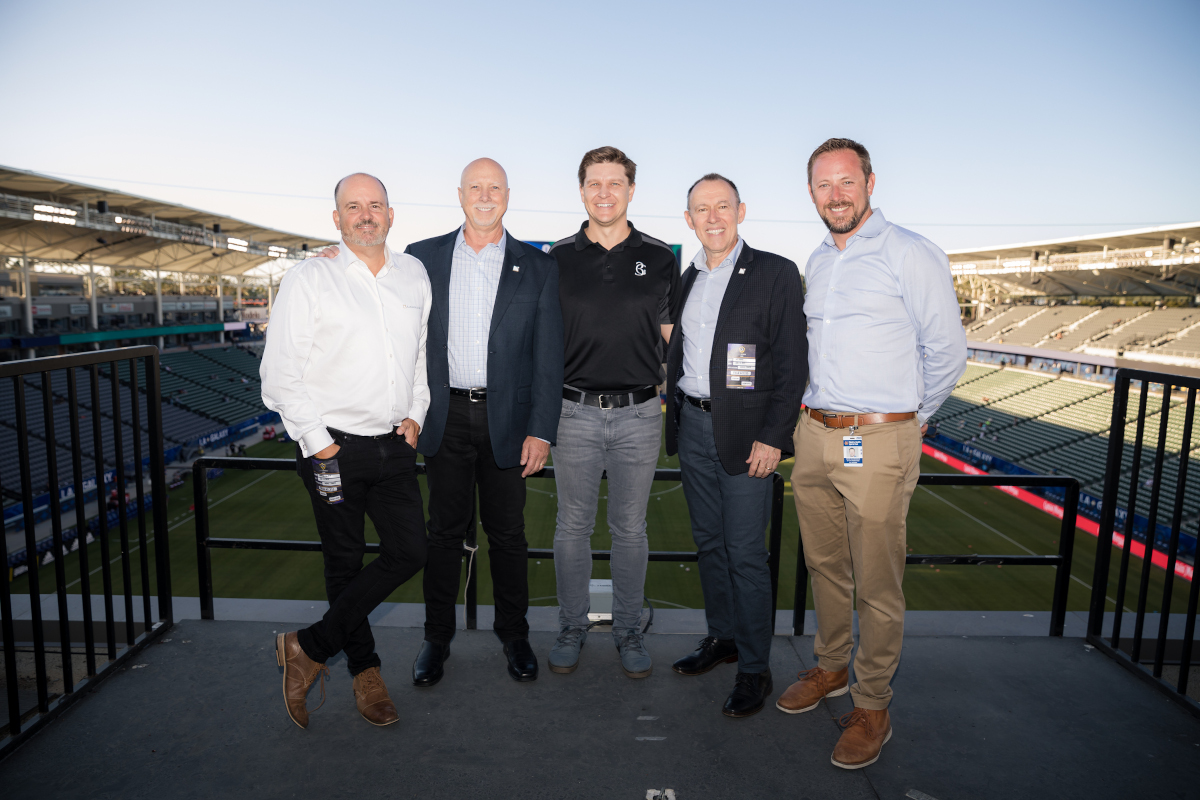
The 3G team did not install a new mixing console; it did expand the existing console’s connectivity options, however. “The existing PreSonus digital audio mixer was modified to include a Dante digital audio card,” Conrad explained. “This allows the existing mixer to join the digital audio network to receive or send audio signal along the network.” 3G Productions also specified two portable 8RU equipment racks that support analog inputs and outputs at the field level. These racks are used for flexible field-level PA applications during practices, cheerleading exhibitions, on-field presentations and tours, etc.
“Each of these two racks are equipped with an AudioScience AVB-to-analog converter capable of eight analog inputs and eight analog outputs for future expansion, an AVB Avunet-compliant network switch, two fiberoptic transceivers, one UPS and a custom I/O panel,” Conrad described. “The I/O panel includes a total of four XLR female connections, four XLR male connections, one Neutrik opticalCON QUAD fiber connector and one RJ45 data connector. We installed custom panels at the north and south field levels to provide one quad multi-mode fiber connection each via a Neutrik opticalCON connector. Two 150-foot-long quad fiber cables provide the connection between these panels and the portable equipment racks.”
The concourse audio system is supported by SFP fiber ports in the head-end network switches; this enables digital audio signal distribution to the concourse via the fiberoptic network. All told, AEG is happy with Dignity Health Sports Park’s new audio systems. According to Duvendeck, the increased sound quality in the main bowl and the addition of low-end audio support have resulted in a fan experience that’s more high energy and engaging—one that lives up to the standards of any professional sports venue. “Without that low end, I think it was completely lacking in delivering the full experience,” Duvendeck said. “Having that low end now has really brought forth the heartbeat of the facility as a whole. You see it in the way that the fans interact with the content we are pushing to the LED boards. When the pregame hype-up video comes up, the lights go down and the music starts to play, you can feel the energy.
Watching the crowd jump to the beat while they scream and cheer is exciting. This installation has really accomplished all we set out to improve. I think we, as a result, have had a much more engaged fanbase.”
Duvendeck added that, post-installation, the noise complaints from the neighbors have dropped off entirely. “Since the commissioning of the system, I don’t know that we’ve had any complaints from the surrounding community related to our in-game sound,” he shared, “which is a welcome change.”
EQUIPMENT
BOWL SYSTEM
NE Speakers
11 L-Acoustics KIVA-II 2-way passive WST enclosures
1 L-Acoustics KIBU-II rigging frame for KIVA-II
1 L-Acoustics KIVA-PULLBACK pullback accessory for KIVA-II
NE Corner Speakers
8 L-Acoustics KIVA-II 2-way passive WST enclosures
1 L-Acoustics KIBU-II rigging frame for KIVA-II
1 L-Acoustics KIVA-PULLBACK pullback accessory for KIVA-II
2 L-Acoustics SB18i-2 high-power subs (1×18)
1 L-Acoustics M-BUMP-I multi-system flying bumper
NW Speakers
11 L-Acoustics KIVA-II 2-way passive WST enclosures
1 L-Acoustics KIBU-II rigging frame for KIVA-II
1 L-Acoustics KIVA-PULLBACK pullback accessory for KIVA-II
NW Corner Speakers
8 L-Acoustics KIVA-II 2-way passive WST enclosures
1 L-Acoustics KIBU-II rigging frame for KIVA-II
1 L-Acoustics KIVA-PULLBACK pullback accessory for KIVA-II
2 L-Acoustics SB18i-2 high-power subs (1×18)
1 L-Acoustics M-BUMP-I multi-system flying bumper
SE Speakers
9 L-Acoustics KIVA-II 2-way passive WST enclosures
1 L-Acoustics KIBU-II rigging frame for KIVA-II
1 L-Acoustics KIVA-PULLBACK pullback accessory for KIVA-II
SE Corner Speakers
8 L-Acoustics KIVA-II 2-way passive WST enclosures
1 L-Acoustics KIBU-II rigging frame for KIVA-II
1 L-Acoustics KIVA-PULLBACK pullback accessory for KIVA-II
2 L-Acoustics SB18i-2 high-power subs (1×18)
1 L-Acoustics M-BUMP-I multi-system flying bumper
SW Speakers
9 L-Acoustics KIVA-II 2-way passive WST enclosures
1 L-Acoustics KIBU-II rigging frame for KIVA-II
1 L-Acoustics KIVA-PULLBACK pullback accessory for KIVA-II
SW Corner Speakers
8 L-Acoustics KIVA-II 2-way passive WST enclosures
1 L-Acoustics KIBU-II rigging frame for KIVA-II
1 L-Acoustics KIVA-PULLBACK pullback accessory for KIVA-II
2 L-Acoustics SB18i-2 high-power subs (1×18)
1 L-Acoustics M-BUMP-I multi-system flying bumper
East Speakers
45 L-Acoustics KIVA-II 2-way passive WST enclosures
5 L-Acoustics KIBU-II rigging frames for KIVA-IIs
5 L-Acoustics KIVA-PULLBACK pullback accessories for KIVA-IIs
10 L-Acoustics SB18i-2 high-power subs (1×18)
5 L-Acoustics M-BUMP-I multi-system flying bumpers
West Speakers
25 L-Acoustics KIVA-II 2-way passive WST enclosures
5 L-Acoustics KIBU-II rigging frames for KIVA-IIs
5 L-Acoustics KIVA-PULLBACK pullback accessories for KIVA-IIs
10 L-Acoustics SB18i-2 high-power subs (1×18)
5 L-Acoustics M-BUMP-I multi-system flying bumpers
West Box Seat Speakers
10 L-Acoustics 5XT 2-way passive coaxial speakers
10 L-Acoustics ETR5 adjustable U-brackets for 5XTs
Amps
5 L-Acoustics LA4X amplified controllers w/PFC (4×1000 w/4Ω)
13 L-Acoustics LA12X amplified controllers (4×2600 w/4Ω)
Installation
12 West Penn 227BK1000 12/2 speaker cables (black)
HEAD-END SYSTEM
Catwalk Rack #1
1 DDB Unlimited OD-50DXC_Custom custom outdoor rack w/air conditioner
1 Middle Atlantic UPS-1000R-IP 1000VA uninterrupted power supply
2 Pakedge FM-10G-LR-01 10G SFP+ fiber modules (1,310nm, 20km)
1 Pakedge S3L-24P 24-port AVB network switch
Catwalk Rack #2
1 DDB Unlimited OD-50DXC_Custom custom outdoor rack w/air conditioner
1 Middle Atlantic UPS-1000R-IP 1000VA uninterrupted power supply
2 Pakedge FM-10G-LR-01 10G SFP+ fiber modules (1,310nm, 20km)
1 Pakedge S3L-24P 24-port AVB network switch
Catwalk Rack #3
1 DDB Unlimited OD-50DXC_Custom custom outdoor rack w/air conditioner
1 Middle Atlantic UPS-1000R-IP 1000VA uninterrupted power supply
2 Pakedge FM-10G-LR-01 10G SFP+ fiber modules (1,310nm, 20km)
1 Pakedge S3L-24P 24-port AVB network switch
Catwalk Rack #4
1 DDB Unlimited OD-50DXC_Custom custom outdoor rack w/air conditioner
1 Middle Atlantic UPS-1000R-IP 1000VA uninterrupted power supply
2 Pakedge FM-10G-LR-01 10G SFP+ fiber modules (1,310nm, 20km)
1 Pakedge S3L-24P 24-port AVB network switch
Portable Field Racks
2 AudioScience Hono ASI2620-2300-1100 AVB appliances (8 analog ins/8 analog outs)
2 Entertainment Metals CU-12023-080217-1 custom quad fiber panels
2 Entertainment Metals CU-12023-080217-2 150′ quad fiber cables, MM w/reels
2 Entertainment Metals Panel_Custom 2Rus
2 Gator G-TOUR 8U 8RU portable equipment racks
1 Middle Atlantic equipment rack hardware
2 Middle Atlantic UPS-1000R-IP 1000VA uninterrupted power supplies
4 Pakedge FM-10G-LR-01 10G SFP+ fiber modules (1,310nm, 20km)
2 Pakedge S3L-24P 24-port AVB network switches
Control Booth Racks (existing)
1 Entertainment Metals Panel_TS custom rackmount panel for touchscreen
1 Middle Atlantic equipment rack hardware
1 Middle Atlantic UPS-2200R-IP 2200VA uninterrupted power supply
1 MOTU Monitor 8 AVB monitor
12 Pakedge FM-10G-LR-01 10G SFP+ fiber modules (1,310nm, 20km)
3 Pakedge S3L-24P 24-port AVB network switches
1 PreSonus SL-Dante-MIX Dante option card for PreSonus mixer
2 QSC CAES4 4-channel AES/EBU I/O cards (local I/O)
4 QSC CAN32 Q-SYS AVB bridge cards
2 QSC CDN64 Dante bridge cards (64×64)
2 QSC CIML4 4-channel analog input cards (local I/O)
2 QSC COL4 4-channel analog output cards (local I/O)
2 QSC Core 510i integrated hardware processors w/8 I/O card slots (256×256)
2 QSC IO FRAME kits w/4 I/O card slots
2 QSC MD-S small media drive kits (130 hours audio)
1 QSC TSC-7w Q-SYS 7″ touchscreen controller
1 SuperLogics SL-1U-AH270M-LG 1RU rackmount PC (i5/16GB/500GB)
1 SuperLogics SL-RMKB-17-DF117 rackmount keyboard/mouse/monitor/DVI
Installation
1 West Penn 454BK1000 mic/line cable
6 West Penn WP9E045T 6-strand OM4 multimode fiber (1,000′)
CONCOURSE SYSTEM
West Concourse Speakers
15 Community R.5-66TZ 12″ horn-loaded speakers (60°x60°, grey)
15 Community PMB-2RR pole-mount brackets w/pan capabilities
1 Community BAND100FT pole-mounting bracket banding (100′)
NW Gate Speakers
2 Community R.5-94TZ 12″ horn-loaded speakers (90°x40°, grey)
2 Community PMB-2RR pole-mount brackets w/pan capabilities
4 Community PMB-BAND pole-mounting bracket banding (92″)
East Concourse Speakers
27 Community R.35COAX 10″ coaxial 2-way speakers (grey)
27 Community rotation/pan yokes for R.35COAXes
NE Gate Speakers
1 Community R.5-66TZ 12″ horn-loaded speaker (60°x60°, grey)
1 Community R.5-94TZ 12″ horn-loaded speaker (90°x40°, grey)
2 Community PMB-2RR pole-mount brackets w/pan capabilities
4 Community PMB-BAND pole-mounting bracket banding (92″)
South Concourse Speakers
11 Community R.5-66TZ 12″ horn-loaded speakers (60°x60°, grey)
1 Community R.5-94TZ 12″ horn-loaded speaker (90°x40°, grey)
11 Community R.35COAX 10″ coaxial 2-way speakers (grey)
12 Community PMB-2RR pole-mount brackets w/pan capabilities
1 Community BAND100FT pole-mount bracket banding (100′)
11 Community rotation/pan yokes for R.35COAXes
SW Gate Speakers
2 Community R.5-94TZ 12″ horn-loaded speakers (90°x40°, grey)
2 Community PMB-2RR pole-mount brackets w/pan capabilities
4 Community PMB-BAND pole-mounting bracket banding (92″)
SE Gate Speakers
2 Community R.5-66TZ 12″ horn-loaded speakers (60°x60°, grey)
2 Community R.35COAX 10″ coaxial 2-way speakers (grey)
2 Community PMB-2RR pole-mount brackets w/pan capabilities
2 Community rotation/pan yokes for R.35COAXes
Restroom Speakers
32 Community AD-C6T 6″ 2-way ceiling speakers
Amps
10 QSC CXD 4.5Q 4-channel amps
Concourse Equipment Racks
5 Middle Atlantic UPS-1000R-IP 1000VA uninterrupted power supplies
10 Pakedge FM-10G-LR-01 10G SFP+ fiber modules (1,310nm, 20km)
5 Pakedge S3L-24P 24-port AVB network switches
6 West Penn AQ227BK1000 12/2 water block speaker cables (1,000′)
TENNIS COURT SYSTEM
Court-Facing Speakers
8 Community R.5-99TZ 12″ horn-loaded speakers (60°x60°, grey)
Concourse-Facing Speakers
14 QSC AD-S8TBK 8″ 2-way surface-mount speakers
Amps
2 QSC CXD4.5 4-channel power amps (1,000W/channel @ 70V)
2 QSC CXD4.3 4-channel power amps (500W/channel @ 70V)
List is edited from information supplied by 3G Productions Inc.
